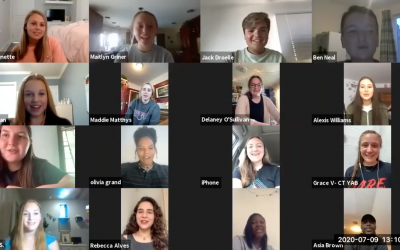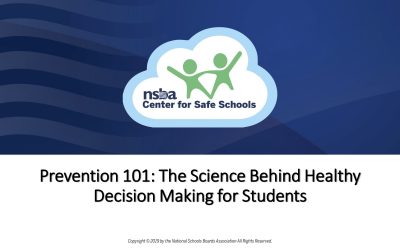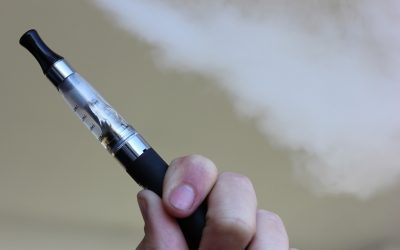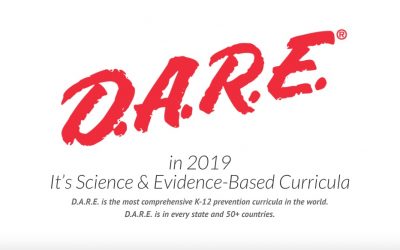
Navigating teen life while confronted with current issues like vaping, teen suicide, social media bullying, and illicit drugs, including today’s opioid epidemic, mean young people today must make critical choices at an early age.
The hopeful news is communities that work together can make a big difference in the lives of children and young adults.
For 36 years, D.A.R.E. has been committed to helping young people make good decisions that support a safe and healthy life, and we’ve learned a few things about effective prevention through partnering with schools, families, and law enforcement in communities across the United States and the world.
Today, communities can implement prevention programming that is more effective than ever, with decades of scientific evidence guiding the way. Here are three big ideas that are supported by research:
- Effective prevention programs are community-wide, with consistent messaging about risk behavior appearing in more than one setting. For example, school-based prevention programming that is reinforced by family talks at home or a city-wide social norms campaign. Community programming should address issues highly relevant to the local area. Families can boost this effect by encouraging conversation about risk behaviors at home. It helps when many community members are involved in shaping teens’ thoughts about challenging issues — especially when they offer an opportunity to see things in new ways. Pacific Grove (Calif.) Police Department school resource officer Justin Hankes sees this happen almost every day at the schools he serves. He says “getting the chance to connect with students and teachers in the classroom provides each of us with a broader understanding of the other’s perspective — we live in the same community and want to live happy and healthy lives. My job allows me to connect with kids in my community to foster leadership and a culture of safety and care.”
- Another thing to look for is long-term prevention programming. Although speakers or school assemblies may provide information or a motivational boost, they are most effective when they supplement an effective program that connects with kids at multiple ages or grade levels, with repeated contacts over time. It takes time to build the skills needed to avoid risk with good decisions. To maximize success, it’s critical for kids to practice these skills when they are young. It’s equally important that teens continue to be engaged in prevention activities at the ages when they will start to be faced with new challenges, in order to effectively apply these skills in real-life scenarios.
- Good prevention programs for elementary-age children are based in social-emotional learning — teaching kids the skills they need to understand and communicate how they are feeling, exercise control over their bodies and minds, and to interact with others. As children transition into middle and high school, programs should continue to focus on peer relationships and social competence at a more complex level. Programs should help teens develop the knowledge and experience to make decisions that align with their own values and goals, and the skills to effectively and confidently express their choices, even under pressure.
By Ashley Frazier, Ph.D., Director of Curriculum and Training, D.A.R.E. America
D.A.R.E. keepin’ it REAL Elementary School Curriculum is Evidence-based, Successful and Effective
An Evaluation of the “D.A.R.E.: keepin’ it REAL” Elementary School Program
Key Findings
The “D.A.R.E.: keepin’ it REAL” elementary school program is delivered by certified D.A.R.E. officers with high fidelity and their delivery is engaging to students. It is effective and successful in the long-term reduction of drinking alcohol, getting drunk, smoking cigarettes, and vaping. The program was also shown to be entirely successful in preventing marijuana use.
The Role and Preparation of School Resource Officers
There is an opportunity for law enforcement and schools to partner in a way that elevates both institutions and is potentially transformative in building trust and cooperation between community members. If school communities decide that having law enforcement on site…
Thank you, D.A.R.E. Officers!
Surgeon General Sounds Alarm On Risk Of Marijuana Addiction And Harm
At a time when more than 30 states and the District of Columbia have legalized the use of marijuana for either medical or recreational use, the U.S. surgeon general says no amount of the drug is safe for teens, young adults and pregnant women.
“While the perceived harm of marijuana is decreasing, the scary truth is that the actual potential for harm is increasing,” Surgeon General Jerome Adams said…
Prevention 101: The Science Behind Healthy Decision Making for Students
The D.A.R.E. America – National School Board Association webinar conducted by Richard Clayton, PhD and David L. Wyrick, PhD on August 13, 2019 is now online to view. The webinar will help the listener understand the evidence and theoretical base underlying Prevention Science, identifying the D.A.R.E. curricula as a model program. The D.A.R.E. curricula focuses on providing cutting edge instruction that helps prevent drug use by developing basic, core Socio-Emotional skills needed for safe and responsible choices…
D.A.R.E. Launches New High School Curriculum
myPlaybook: Core is a four-lesson curriculum designed for delivery to High School Students, ideally in 9th or 10th grade. The lesson content is aligned with D.A.R.E. Elementary and Middle school program concepts, continuing the focus on understanding risk behavior…
D.A.R.E. Partners with American Foundation for Suicide Prevention to Launch “More than Sad”…Teen Mental Health Enhancement Lesson
More Than Sad is a 45 minute enhancement lesson designed for delivery by D.A.R.E. Officers to High School students, ideally in 9th or 10th grade. D.A.R.E. collaborated with the American Foundation for Suicide Prevention (AFSP) to adapt this lesson for delivery by…
D.A.R.E. Responds to Vaping Crisis with New Enhancement Lesson
Vaping nicotine nearly doubled among high school seniors from 11 percent in 2017 to 20.9 percent in 2018. More than 1 in 10 eighth graders (10.9 percent) say they vaped nicotine in the past year, and use is up significantly in virtually all vaping measures among…
D.A.R.E. in 2019 – It’s Science & Evidence-Based Curricula
Read an article about D.A.R.E. by Richard Clayton, Ph.D., former Chair of Health Education and Health Promotion in the College of Public Health at the University of Kentucky. For more than 20 years, he was the director of the federally funded Center for Prevention Research
Copyright © 2022 D.A.R.E. America. All Rights Reserved.
Copyright © 2022 D.A.R.E. America.
All Rights Reserved.












